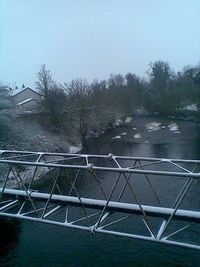Colebrooke River: Difference between revisions
A.N. Other (talk | contribs) No edit summary |
No edit summary |
||
| Line 1: | Line 1: | ||
[[Image:Colebrooke_river.jpg|thumb|200px|A stretch of the River Colebrooke in Maguiresbridge]] | [[Image:Colebrooke_river.jpg|thumb|200px|A stretch of the River Colebrooke in Maguiresbridge]] | ||
The '''Colebrooke River''' is a river in [[County Fermanagh]], [[Northern Ireland]]. | The '''Colebrooke River''' is a river in [[County Fermanagh]], [[Northern Ireland]]. Its source is in the Sliabh Beagh mountains where its known as the ''Many Burns''. | ||
The river | The river flows in a south-westerly direction, through [[Maguiresbridge]], before merging with the [[Tempo River]] and finally entering [[Upper Lough Erne]] near Inishcollan, [[Lisnaskea]].<ref>{{cite web | title=Rivers - From ''Atlas and Cyclopedia of Ireland'' (1900) | work=Library Ireland | url=http://www.libraryireland.com/Atlas/Fermanagh.php | accessdate=2007-11-28}}</ref> | ||
==Angling== | ==Angling== | ||
Revision as of 20:19, 9 January 2010

The Colebrooke River is a river in County Fermanagh, Northern Ireland. Its source is in the Sliabh Beagh mountains where its known as the Many Burns.
The river flows in a south-westerly direction, through Maguiresbridge, before merging with the Tempo River and finally entering Upper Lough Erne near Inishcollan, Lisnaskea.[1]
Angling
The river has abundant large bream, roach, perch, rudd and pike. Salmon and Lough Erne trout can be caught towards the end of the season when moving from the Lough to spawning grounds in the upper reaches of the river.[2][3] Some of the river is private fishing water on the Colebrooke Park estate.[4][5]
References
- ↑ "Rivers - From Atlas and Cyclopedia of Ireland (1900)". Library Ireland. http://www.libraryireland.com/Atlas/Fermanagh.php. Retrieved 2007-11-28.
- ↑ "Colebrooke River". Discover Northern Ireland. http://www.discovernorthernireland.com/shortbreaks/product.aspx?ProductID=2436. Retrieved 2007-11-28.
- ↑ "Colebrook River". DCAL - Fishing NI. http://www.dcal-fishingni.gov.uk/riversinfo/default.asp?river=ColebrookRiver-WILD. Retrieved 2007-11-28.
- ↑ "Colebrooke River". Guided Fishing. http://www.jxbreslin.com/new_page_4.htm. Retrieved 2007-11-28.
- ↑ "Colebrook Park Fishing". Colebrooke Park. http://www.colebrooke.info/fishing.htm. Retrieved 2007-11-28.